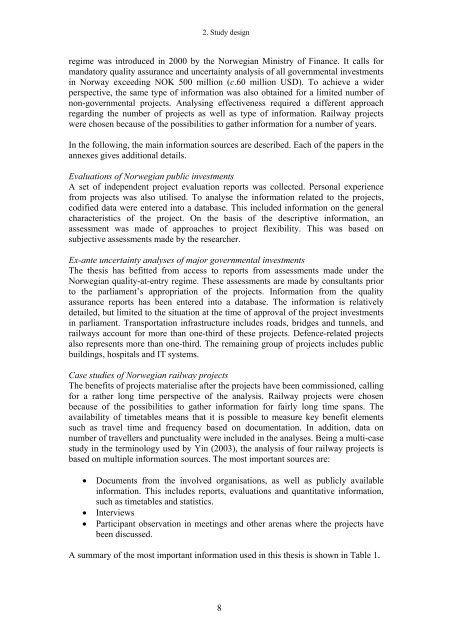Link to thesis - Concept - NTNU
Link to thesis - Concept - NTNU
Link to thesis - Concept - NTNU
Create successful ePaper yourself
Turn your PDF publications into a flip-book with our unique Google optimized e-Paper software.
2. Study designregime was introduced in 2000 by the Norwegian Ministry of Finance. It calls formanda<strong>to</strong>ry quality assurance and uncertainty analysis of all governmental investmentsin Norway exceeding NOK 500 million (c.60 million USD). To achieve a widerperspective, the same type of information was also obtained for a limited number ofnon-governmental projects. Analysing effectiveness required a different approachregarding the number of projects as well as type of information. Railway projectswere chosen because of the possibilities <strong>to</strong> gather information for a number of years.In the following, the main information sources are described. Each of the papers in theannexes gives additional details.Evaluations of Norwegian public investmentsA set of independent project evaluation reports was collected. Personal experiencefrom projects was also utilised. To analyse the information related <strong>to</strong> the projects,codified data were entered in<strong>to</strong> a database. This included information on the generalcharacteristics of the project. On the basis of the descriptive information, anassessment was made of approaches <strong>to</strong> project flexibility. This was based onsubjective assessments made by the researcher.Ex-ante uncertainty analyses of major governmental investmentsThe <strong>thesis</strong> has befitted from access <strong>to</strong> reports from assessments made under theNorwegian quality-at-entry regime. These assessments are made by consultants prior<strong>to</strong> the parliament’s appropriation of the projects. Information from the qualityassurance reports has been entered in<strong>to</strong> a database. The information is relativelydetailed, but limited <strong>to</strong> the situation at the time of approval of the project investmentsin parliament. Transportation infrastructure includes roads, bridges and tunnels, andrailways account for more than one-third of these projects. Defence-related projectsalso represents more than one-third. The remaining group of projects includes publicbuildings, hospitals and IT systems.Case studies of Norwegian railway projectsThe benefits of projects materialise after the projects have been commissioned, callingfor a rather long time perspective of the analysis. Railway projects were chosenbecause of the possibilities <strong>to</strong> gather information for fairly long time spans. Theavailability of timetables means that it is possible <strong>to</strong> measure key benefit elementssuch as travel time and frequency based on documentation. In addition, data onnumber of travellers and punctuality were included in the analyses. Being a multi-casestudy in the terminology used by Yin (2003), the analysis of four railway projects isbased on multiple information sources. The most important sources are:Documents from the involved organisations, as well as publicly availableinformation. This includes reports, evaluations and quantitative information,such as timetables and statistics.InterviewsParticipant observation in meetings and other arenas where the projects havebeen discussed.A summary of the most important information used in this <strong>thesis</strong> is shown in Table 1.8
















